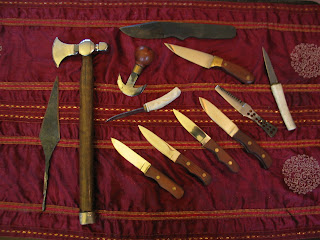I had 2 starts into knifemaking. Back in 1991 I was a teenager into
knives and our local butcher was also a knifemaker by the name of
Peter Bennett. He gave me some steel for my first knives and I spent
some time in his workshop. Unfortunately I moved out of the area and
lacking a workshop those knives sat in my drawer until 2005 when I saw
an ad for the bladesmithing course Karim Haddad runs at The Tharwa
Valley Forge. I signed up for the course and finished first my first
knife in Feburary of 2005.
I always used a knife as part of camping in scouts and for skinning
rabbits when we went hunting. I never had much of a need for a large
knife for chopping firewood or bush bashing etc so I have tending to
focus on useful every day carry knives in particular folding knives.
Aside from that there is a real appeal to a well finished hand made
knife. Plus it gives you the creativity to try some really different
things out.
A lot of newer Knifemakers have the advantage of the wealth of information provided by online forums & tutorials to help them get started. Did you have it so easy?
All the books and dvds and information on the internet helps for sure
but nothing beats getting into the workshop and getting your hands
dirty. I have been pretty lucky in that I have lived reasonably close
to some very helpful knifemakers that have helped get me started.
What's your design process? Sketch, Cad, or do you just get straight to work? Where do you source your inspiration for your designs?
I tend to start with an idea of what type of knife I am going to make -
how big does it need to be and what is it going to be used for? From
there I start sketching out the flow of the knife; how the handle flows
into the blade, how it is going to be held? At this point I don't
worry too much about the dimensions of the knife. If I get something I
like I will scan it in and re-size it on the computer until I get the
blade dimensions I am looking for. Then I will print it out and start
trying to fit the blade into the handle of the folder. I would like to
get started with CAD but at this stage hand drawing with lots of bits
of tracing paper covered in different blades and handle shapes are the
way to go.
Do your knives say anything about where you're from?
Not really, aside from liking to use Australian wood in my handles that
is about the only length I go to to make them locally made. I have
made one knife that was expressly Aussie in flavour with carved Red
Gum handle scales in the shape of a gum leaf.
What's your preferred style of knife to make?
I like making folders. I have been focusing on slipjoint folders at
present but I plan on trying out some locking knives as well. Probably
liner locks or frame locks. I have been using flat grinds so far.
How long typically, will a knife take for you to build?
Depends on the knife. A folder with double bolsters etc will take up
to 20 hours. I would say I probably average about 16 hours for a slip
joint though.
What's your favourite material/s to use in your handles and blades? Preferred finishes?
I have been using O1 and ATS-34 for my folders. For my forged blades I
have been using either 1055, 1075 or 5160 for a larger blade. I have
really taken a liking to 410/416 stainless liners and bolsters, they
come up with a nice finish either polished or hand rubbed satin
finish. I have been trying some bead blasted finish on my neck knives but I
really prefer a hand rubbed finish, it is part of what separates a
hand made knife from a production knife.
Have you had any strange requests for knife/kit design?
Not really. The weirdest one so far was for a "Big Stabby Knife" as a
present from a friend to her husband. I was really hoping it wasn't
going to be given pointy end first.
What's the greatest challenge you've had in Knifemaking? Any regrets?
I regret waiting so long to get back into knifemaking. The biggest
challenge was learning to make folding knives without a doubt. There
is a reasonable amount of info on copying a knife design but very
little in producing your own design. Of course once you have made 10
or so folders and understand the mechanics of it all the designing
becomes a lot easier.
Do you make anything aside from knives?
Nope, making knives satisfies all my creative urges at present.
Where do you see your Knifemaking going in the next few years?
More and more folders. Improving on the fit and finish of them. I
would like to diversify the types and patterns of my folders a bit
more. Have some real user knives at hopefully reasonable prices as
well as doing some more damascus blades and higher end handle
materials to show off. I will still be focusing on smaller folders
though; stuff that can fit in the money pocket of your jeans up to
about 4 inches closed length.
What knife do you carry?
The first slipjoint I made. A take apart folder. It is a really nice
size and has sentimental value.
 |  |  |
More information about Alistair and his knife making can be found here
Photos courtesy of Alistair Phillips







.JPG)
.JPG)
.JPG)









































